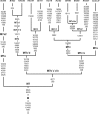Phylogeographic analysis of mitochondrial DNA in northern Asian populations
- PMID: 17924343
- PMCID: PMC2265662
- DOI: 10.1086/522933
Phylogeographic analysis of mitochondrial DNA in northern Asian populations
Abstract
To elucidate the human colonization process of northern Asia and human dispersals to the Americas, a diverse subset of 71 mitochondrial DNA (mtDNA) lineages was chosen for complete genome sequencing from the collection of 1,432 control-region sequences sampled from 18 autochthonous populations of northern, central, eastern, and southwestern Asia. On the basis of complete mtDNA sequencing, we have revised the classification of haplogroups A, D2, G1, M7, and I; identified six new subhaplogroups (I4, N1e, G1c, M7d, M7e, and J1b2a); and fully characterized haplogroups N1a and G1b, which were previously described only by the first hypervariable segment (HVS1) sequencing and coding-region restriction-fragment-length polymorphism analysis. Our findings indicate that the southern Siberian mtDNA pool harbors several lineages associated with the Late Upper Paleolithic and/or early Neolithic dispersals from both eastern Asia and southwestern Asia/southern Caucasus. Moreover, the phylogeography of the D2 lineages suggests that southern Siberia is likely to be a geographical source for the last postglacial maximum spread of this subhaplogroup to northern Siberia and that the expansion of the D2b branch occurred in Beringia ~7,000 years ago. In general, a detailed analysis of mtDNA gene pools of northern Asians provides the additional evidence to rule out the existence of a northern Asian route for the initial human colonization of Asia.
Figures






References
Web Resources
-
- Arlequin, http://anthropologie.unige.ch/arlequin/ (for software v. 3.01)
-
- Free Phylogenetic Network Software, http://www.fluxus-engineering.com/sharenet.htm (for the Network 4.1.0.9 software package)
-
- GenBank, http://www.ncbi.nlm.nih.gov/Genbank/ (for 71 complete mtDNA sequences [accession numbers EF153771–EF153833, EF397558–EF397562, and EF486517–EF486519])
References
-
- Vasiliev SA (1993) The Upper Paleolithic of northern Asia. Curr Anthropol 34:82–9210.1086/204141 - DOI
-
- Vasil’ev SA, Kuzmin YV, Orlova LA, Dementiev VN (2002) Radiocarbon-based chronology of the Paleolithic in Siberia and its relevance to the peopling of the New World. Radiocarbon 44:503–530
Publication types
MeSH terms
Substances
Associated data
- Actions
- Actions
- Actions
- Actions
- Actions
- Actions
- Actions
- Actions
- Actions
- Actions
- Actions
- Actions
- Actions
- Actions
- Actions
- Actions
- Actions
- Actions
- Actions
- Actions
- Actions
- Actions
- Actions
- Actions
- Actions
- Actions
- Actions
- Actions
- Actions
- Actions
- Actions
- Actions
- Actions
- Actions
- Actions
- Actions
- Actions
- Actions
- Actions
- Actions
- Actions
- Actions
- Actions
- Actions
- Actions
- Actions
- Actions
- Actions
- Actions
- Actions
- Actions
- Actions
- Actions
- Actions
- Actions
- Actions
- Actions
- Actions
- Actions
- Actions
- Actions
- Actions
- Actions
- Actions
- Actions
- Actions
- Actions
- Actions
- Actions
- Actions
- Actions
LinkOut - more resources
Full Text Sources

